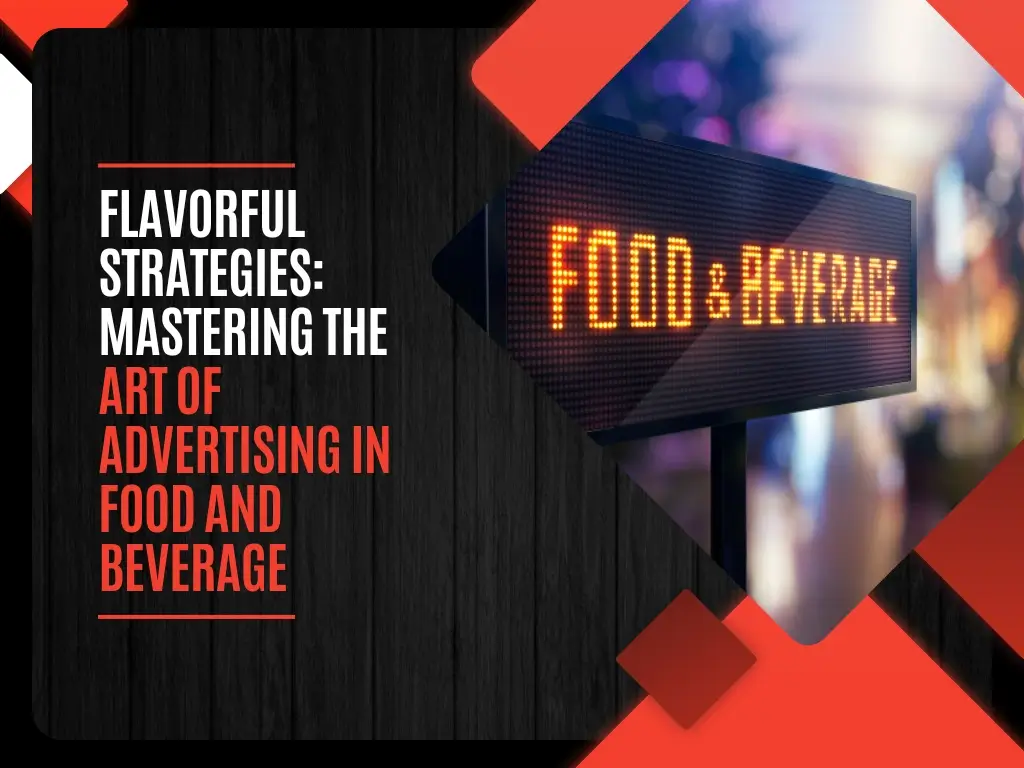Flavorful Strategies: Mastering the Art of Advertising in Food and Beverage

Advertising your client’s products in the food and beverage industry requires a strategic approach that combines creativity, understanding of the target audience, and knowledge of current market trends. This is a compilation of the best practices in advertising for these products:
1. Understand the Target Audience
The first step in any successful advertising campaign is to identify and understand the target audience. This includes demographic factors such as age, gender, income level, and lifestyle preferences. In the food and beverage industry, psychographics also play a crucial role—what are their values, interests, and eating habits?
For example, if your client offers organic snacks, the target audience might be health-conscious consumers who prioritize sustainable products. Conducting surveys, focus groups, and analyzing existing customer data can provide valuable insights.
2. Develop a Unique Selling Proposition (USP)
In a crowded market, a unique selling proposition is essential. What makes your client’s products stand out from competitors? This could be the quality of ingredients, unique flavors, packaging, or the brand’s commitment to sustainability.
Once the USP is defined, it should be consistently communicated across all advertising platforms. This helps create a strong brand identity that resonates with consumers and builds loyalty.
3. Leverage Digital Marketing
Digital marketing is crucial in today’s advertising landscape. Here are several components to focus on:
a. Social Media Marketing
Platforms like Instagram, Facebook, and TikTok are particularly effective for food and beverage brands. Engaging visuals of the products can attract attention, while stories and reels can showcase recipes, behind-the-scenes content, or customer testimonials.
Consider influencer partnerships to expand reach. Influencers who align with your client’s brand values can introduce products to new audiences authentically.
b. Content Marketing
Creating valuable content related to the products can attract potential customers. This might include blog posts about the health benefits of certain ingredients, recipes using the products, informative videos that tell the brand’s story and employing experts specialized in professional photos for restaurants and food businesses. All these elements working in sync can boost the quality of your content tremendously.
SEO (Search Engine Optimization) is also important. Use relevant keywords to help the content rank higher in search results, making it easier for consumers to discover the brand online.
c. Email Marketing
Email campaigns can be an effective way to keep customers informed about new products, promotions, and events. Personalizing these emails based on customer preferences can significantly enhance engagement. For instance, sending tailored recipes or product recommendations can make customers feel valued.
4. Utilize Traditional Advertising
While digital marketing is essential, traditional advertising methods should not be overlooked. Depending on the target audience, consider the following:
a. Print Advertising
Magazines, newspapers, and flyers can still be effective, particularly for local or niche markets. Engaging visuals and clear calls to action can drive consumers to try your client’s products.
b. In-Store Promotions
Sampling events, promotional displays, and point-of-sale advertising can capture the attention of consumers at the moment of decision. Collaborating with retailers to create attractive displays can boost visibility and sales.
c. Outdoor Advertising
Billboards, public transport ads, and posters in strategic locations can reach a broad audience. Effective outdoor ads should be visually striking and convey the product’s USP clearly.
5. Engage in Experiential Marketing
Experiential marketing allows consumers to interact with the brand in a memorable way. This could involve hosting tastings, food festivals, or pop-up events where consumers can sample products.
Creating an immersive experience fosters a deeper connection with the brand, making it more likely for consumers to share their experiences on social media, further amplifying the brand’s reach.
6. Incorporate Sustainability and Social Responsibility
Today’s consumers are increasingly concerned about sustainability and ethical practices. If your client emphasizes these values, it should be prominently featured in advertising efforts. Highlighting sustainable sourcing, eco-friendly packaging, or community support initiatives can resonate strongly with the audience and build trust.
7. Monitor and Analyze Campaign Performance
Once the advertising campaign is launched, it’s crucial to monitor its performance continuously. Use analytics tools to track engagement, reach, and conversion rates.
This data can provide insights into what’s working and what needs adjustment. For example, if a social media ad is driving high engagement but low sales, it may indicate that the call to action needs to be more compelling or that the landing page isn’t optimized for conversions.
8. Gather and Utilize Customer Feedback
Encouraging customer feedback can provide valuable insights into how the products are perceived. This could be through online reviews, social media interactions, or post-purchase surveys.
Utilize positive feedback in advertising materials, and address any negative feedback transparently and promptly. Demonstrating responsiveness to customer concerns can enhance brand loyalty.
Conclusion
In conclusion, effective advertising for food and beverage products requires a multi-faceted approach that integrates digital and traditional marketing strategies while staying attuned to consumer preferences and market trends. By understanding the target audience, developing a unique selling proposition, leveraging various marketing channels, and emphasizing sustainability, your client can create impactful advertising campaigns that drive engagement and sales. Continuous monitoring and adaptation will ensure that the advertising strategy remains effective and resonates with the evolving consumer landscape.

